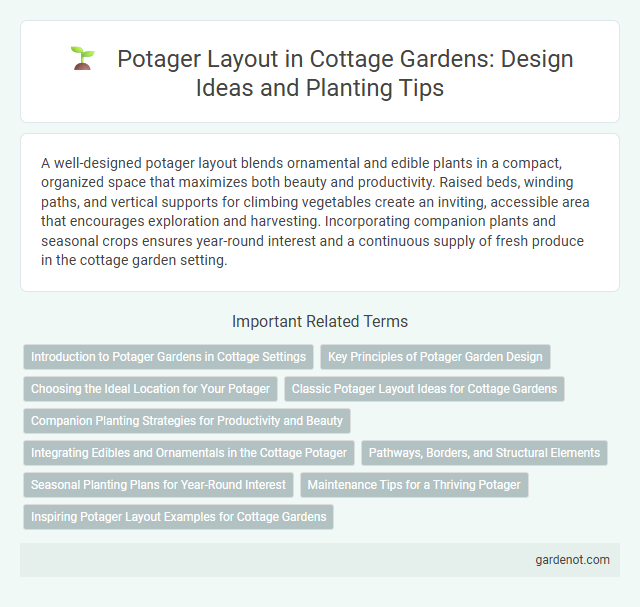A well-designed potager layout blends ornamental and edible plants in a compact, organized space that maximizes both beauty and productivity. Raised beds, winding paths, and vertical supports for climbing vegetables create an inviting, accessible area that encourages exploration and harvesting. Incorporating companion plants and seasonal crops ensures year-round interest and a continuous supply of fresh produce in the cottage garden setting.
Introduction to Potager Gardens in Cottage Settings
Potager gardens in cottage settings integrate ornamental and edible plants, creating a harmonious blend of beauty and functionality. These layouts typically feature raised beds, winding pathways, and companion planting that maximizes space while enhancing biodiversity. Vibrant vegetables, herbs, and flowers coexist in a charming, structured arrangement that reflects traditional cottage garden aesthetics.
Key Principles of Potager Garden Design
Potager garden design emphasizes a harmonious blend of edible and ornamental plants arranged in a structured yet visually appealing layout, often featuring geometric beds, pathways, and companion planting. Key principles include maximizing space efficiency through vertical gardening and succession planting, ensuring plant health with crop rotation, and balancing aesthetics with functionality by integrating herbs, vegetables, and flowers. Incorporating focal points such as trellises or ornamental structures enhances the garden's charm while supporting climbing plants and optimizing sunlight exposure.
Choosing the Ideal Location for Your Potager
Selecting the ideal location for your potager involves prioritizing full sun exposure, as most vegetables and herbs require at least six hours of direct sunlight daily to thrive. The soil should be well-drained, fertile, and enriched with organic matter to support healthy plant growth. Proximity to a water source and easy access for maintenance further enhances the efficiency and productivity of your potager garden.
Classic Potager Layout Ideas for Cottage Gardens
Classic potager layouts in cottage gardens emphasize symmetry and functionality, often featuring raised beds arranged in geometric patterns such as squares or rectangles bordered by low hedges like boxwood. Interplanting vegetables, herbs, and edible flowers maximizes space and enhances visual appeal while ensuring easy access through gravel pathways. Incorporating traditional elements such as trellises for climbing plants and central focal points like a small fountain or birdbath elevates the charm and productivity of the potager garden design.
Companion Planting Strategies for Productivity and Beauty
Potager layouts blend edible and ornamental plants using companion planting strategies to enhance productivity and aesthetic appeal. Strategic pairings like tomatoes with basil improve growth and flavor while repelling pests, and planting marigolds nearby deters nematodes and attracts beneficial insects. By optimizing plant compatibility, potagers create vibrant, high-yield gardens that balance beauty with functional biodiversity.
Integrating Edibles and Ornamentals in the Cottage Potager
A cottage potager layout seamlessly blends edible plants like herbs, vegetables, and fruit trees with ornamental flowers and shrubs to create a visually appealing and productive garden space. Strategic placement of companion plants enhances growth while attracting pollinators and deterring pests, promoting a healthy ecosystem. Raised beds, winding paths, and mixed borders contribute to both accessibility and the classic, charming aesthetic of the traditional cottage garden.
Pathways, Borders, and Structural Elements
Potager gardens feature carefully designed pathways that enhance accessibility and define growing areas, often using materials like gravel, brick, or mulch for durability and charm. Borders in potagers are typically formed by low hedges, raised beds, or wooden frames to separate vegetable plots and ornamental plants, creating a structured yet inviting aesthetic. Structural elements such as trellises, arches, and pergolas provide vertical support for climbing plants while adding architectural interest and maximizing garden space.
Seasonal Planting Plans for Year-Round Interest
A well-designed potager layout integrates seasonal planting plans to ensure year-round interest and productivity. Incorporate cool-season crops like kale and spinach in early spring, transition to warm-season vegetables such as tomatoes and beans during summer, and rotate to root vegetables and leafy greens for the fall and winter months. Succession planting combined with companion planting enhances soil health and maximizes space, resulting in a vibrant, functional cottage garden that thrives through every season.
Maintenance Tips for a Thriving Potager
A well-organized potager layout combines vegetable beds, herbs, and flowers to maximize space and maximize biodiversity. Regularly prune and harvest plants to promote healthy growth and prevent overcrowding, which can lead to disease. Incorporate organic mulches to conserve moisture, suppress weeds, and enhance soil fertility for a thriving potager garden.
Inspiring Potager Layout Examples for Cottage Gardens
Inspiring potager layouts for cottage gardens often feature symmetrical beds bordered by herbs and flowers, maximizing both aesthetics and productivity. Raised wooden or stone-edged beds create structure while allowing for companion planting, blending vegetables, fruits, and ornamental plants seamlessly. Integrating winding paths with vintage garden furniture enhances accessibility and charm, turning the potager into a functional and inviting garden centerpiece.
Potager layout Infographic

 gardenot.com
gardenot.com